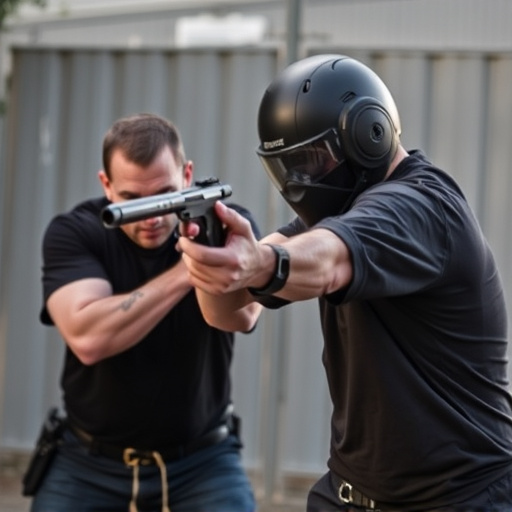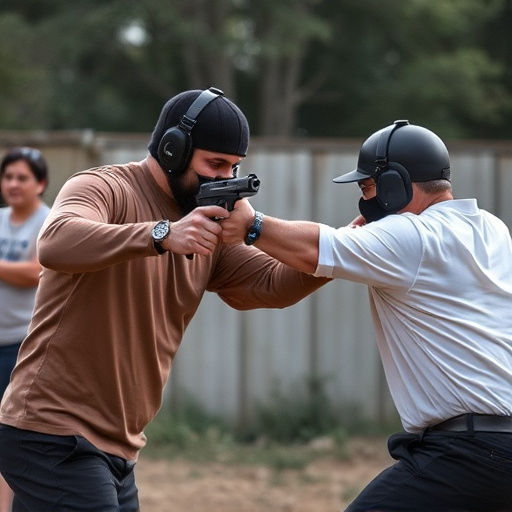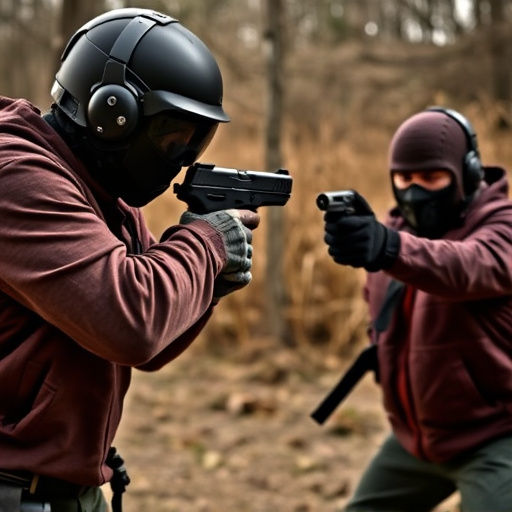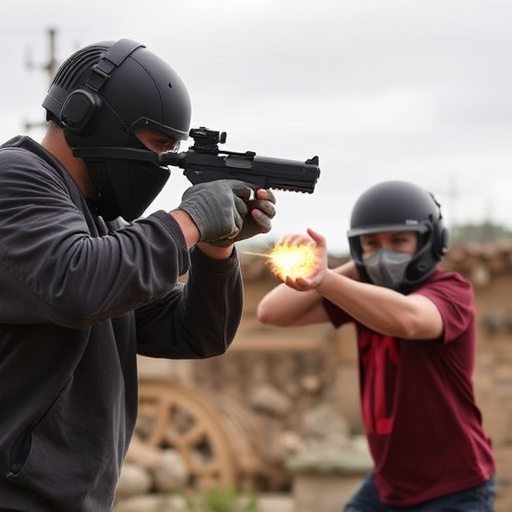Voltage Through Fabrics: Protective Clothing & Stun Gun Safety
Understanding voltage penetration through clothing is crucial when selecting personal protective gea…….
Understanding voltage penetration through clothing is crucial when selecting personal protective gear, especially stun devices like the Top 10 stun guns for personal protection. Higher voltages penetrate thicker fabrics more easily than lower ones, influenced by material type (e.g., dry cotton vs wet or conductive materials), thickness, and structure. Stun guns designed for personal safety maximize voltage penetration to ensure a powerful enough shock to incapacitate an assailant. To protect against electric shocks, consider clothing made of high-performance fabrics like Kevlar or Dyneema, seamless construction, full coverage from neck to ankles, and certifications ensuring compliance with safety standards. The Top 10 stun guns for personal protection often feature high-voltage outputs and specialized prongs designed to disrupt attackers' muscular systems even through heavy jackets. Real-world studies show that while standard clothing offers some protection against lower voltage shocks, it's significantly compromised by higher voltages, emphasizing the need for high-performance protective attire. Experts recommend integrating quality protective gear with stun guns like those in the Top 10 stun guns for personal protection to provide a comprehensive safety strategy.
“Uncovering the mysterious power of voltage penetration through thick clothing is crucial for understanding personal safety. This article delves into the science behind electricity’s journey through fabrics, offering a comprehensive guide for individuals seeking self-defense solutions.
From basic concepts to real-world applications, we explore factors influencing clothing conductivity and provide expert insights on choosing protective gear, including a review of the Top 10 Stun Guns for personal protection. Get ready to navigate the intricacies of safety with informed decisions.”
- Understanding Voltage Penetration: A Basic Overview
- Factors Affecting Clothing's Resistance to Electricity
- Top 5 Considerations When Choosing Protective Clothing
- Analyzing Stun Gun Performance Through Materials
- Case Studies: Real-World Scenarios of Clothing Protection
- Expert Recommendations for Personal Safety Gear
Understanding Voltage Penetration: A Basic Overview

Voltage penetration through clothing is a critical factor to consider when evaluating personal protection tools, particularly when it comes to stun devices like the Top 10 stun guns for personal protection. Understanding how electrical current behaves when passing through different materials is essential for ensuring the effectiveness of these devices. The concept is relatively straightforward: voltage, or electric potential difference, seeks the path of least resistance to flow from a higher potential to lower one. In the context of clothing, this means that higher voltages can penetrate thicker fabrics more easily than lower ones.
Various factors influence voltage penetration, including the type and thickness of the fabric, as well as its moisture content. For instance, dry cotton clothing presents a relatively high resistance to electrical current flow, making it less conducive to voltage penetration. Conversely, wet or conductive materials like metal can significantly lower resistance, allowing higher voltages to pass through more easily. This is why stun guns designed for personal protection often include features that maximize their ability to penetrate clothing effectively, ensuring the delivery of a powerful enough shock to incapacitate an assailant.
Factors Affecting Clothing's Resistance to Electricity

The resistance of clothing to electricity, or its ability to protect against voltage penetration, is influenced by several key factors. First and foremost, the material composition of the fabric plays a critical role. Different fabrics have varying levels of electrical conductivity, with insulators like cotton and wool offering higher resistance compared to conductors like metal threads or synthetic materials treated with conductive coatings. The thickness and density of the clothing are also significant; thicker garments provide more barriers, impeding the flow of electric current.
Additionally, the structure and construction of the clothing item matter. Seamless fabrics or those with intricate weaves can create layers and air pockets that further enhance resistance. On the other hand, tight-knit fabrics allow for minimal space between fibers, making it easier for electricity to conduct. Even the presence of accessories or adornments can introduce electrical pathways, especially if they are metal-based. When considering personal protection, this knowledge is pertinent, especially when reviewing Top 10 stun guns for personal protection, as understanding clothing’s role in electric shock prevention is vital for choosing appropriate defense mechanisms.
Top 5 Considerations When Choosing Protective Clothing

When selecting protective clothing, especially in scenarios where personal safety is paramount, several key factors come into play. Here are the top five considerations to keep in mind, offering a guiding light in choosing gear that can effectively shield against voltage penetration, particularly from Top 10 stun guns for personal protection.
Firstly, material composition is pivotal. Look for clothing made from high-performance, dense fabrics like Kevlar or Dyneema, renowned for their exceptional resistance to punctures and cuts. These materials significantly reduce the likelihood of electrical current flowing through your garments. Secondly, consider the garment’s construction; seamless designs offer superior protection by eliminating potential entry points for voltage. Thirdly, ensure the clothing provides adequate coverage, encompassing all vital areas from neck to ankles. Fourthly, check for certifications and standards compliance, such as EN 470 or similar, guaranteeing the gear meets rigorous safety requirements. Lastly, weight and comfort should not be overlooked; lighter, breathable options enhance mobility without compromising protection.
Analyzing Stun Gun Performance Through Materials

When evaluating the effectiveness of a stun gun, understanding how voltage penetrates through different materials is crucial. Stun guns are designed to disrupt an attacker’s muscular system, and their performance can vary greatly depending on the clothing worn by the target. For personal protection, choosing a stun gun that delivers a powerful jolt through thick fabrics is essential for ensuring its reliability in real-world scenarios.
The Top 10 stun guns for personal protection often prioritize high voltage outputs and specialized prongs or electrodes to penetrate various materials, including heavy jackets and even ballistic vests. These devices are engineered to provide consistent performance, regardless of the clothing barrier, allowing users to incapacitate attackers effectively. Testing and reviews highlight the importance of these features, especially in situations where quick response and penetration through thick clothing are vital for self-defense.
Case Studies: Real-World Scenarios of Clothing Protection

In real-world scenarios, the effectiveness of clothing as a protective barrier against electrical currents, particularly from stun devices like the Top 10 stun guns for personal protection, has been explored through various case studies. One notable example involves individuals who have encountered stun guns in high-risk environments, such as law enforcement officers or security personnel working in dangerous neighborhoods. Studies show that while standard clothing may offer some level of protection against lower voltage shocks, it can be significantly compromised when exposed to higher voltages typically delivered by modern stun guns.
These case studies highlight the importance of understanding the penetration capabilities of electrical currents through fabrics. For instance, heavy duty workwear or tactical gear designed with advanced materials and construction methods have been found to provide better protection than traditional clothing. Researchers emphasize that the thickness, material composition, and overall quality of clothing play crucial roles in determining its effectiveness against voltage penetration. This knowledge is particularly valuable for individuals seeking personal protection, encouraging them to invest in high-performance protective attire when considering options like the Top 10 stun guns for personal security.
Expert Recommendations for Personal Safety Gear

When it comes to personal safety, especially in situations where voltage penetration through thick clothing is a concern, experts recommend investing in quality personal protective gear. One crucial tool often featured in the Top 10 stun guns for personal protection is the stun gun itself. These devices deliver powerful electric shocks that can immobilize an attacker, providing precious time to escape dangerous circumstances.
Additionally, wearing protective clothing designed with conductive materials can significantly reduce the risk of voltage penetration. Look for gear that incorporates special fabrics or shielding technologies that disrupt the path of electrical current. Combining such clothing with a stun gun offers a multi-layered approach to safety, ensuring you’re prepared for various scenarios.
In conclusion, understanding voltage penetration through thick clothing is paramount for personal safety, especially when faced with threats like stun guns. The article has explored key factors influencing clothing’s resistance to electricity, provided insights into effective protective clothing choices, analyzed stun gun performance across materials, and presented real-world case studies. For those seeking robust personal protection, considering the top 10 stun guns recommended by experts can be a significant step towards enhancing safety in various scenarios. Staying informed and equipped is essential for navigating potential risks with confidence.


